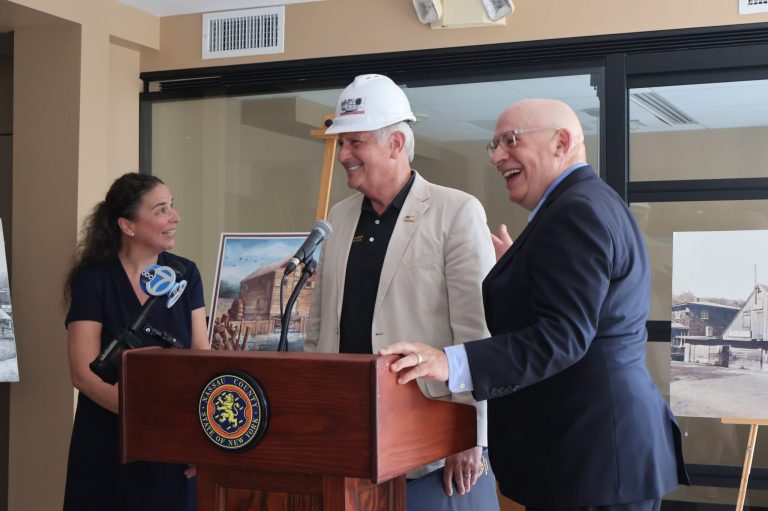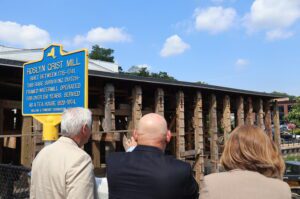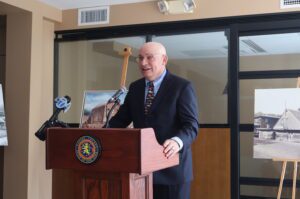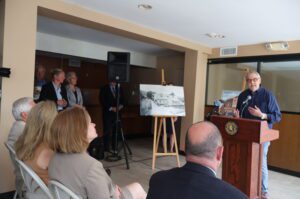
The historic Roslyn Grist Mill, a rare and historic example of Dutch wood-framed industrial architecture, achieved a milestone on July 25, as the steel beams supporting the mill were removed and the timber frame lowered onto its new foundation; ending Phase 1 of renovations.
Now, the mill enters Phase 2 of its extensive restoration process which will focus on the interior and addition of a water wheel.
“Nassau County has invested about two and a half million dollars in this project,” Nassau County executive Bruce Blakeman said at the press conference inside the structure. “And we are very proud of that investment. Because this is a way to secure a historical site that couldn’t be replaced otherwise, money can’t buy what you have here.”
Blakeman said he took pride in the joint effort between the government, the community, and the private sector.
Blakeman has challenged the Roslyn Landmark Society to finish major restorations by 2024, which is the 125th anniversary of the founding of Nassau County.
Benjamin D. Hicks, who advocated for the forming of Nassau County, owned the grist mill at one point.
This mill, which operated for over 150 years and played host to a visit from President George Washington who made mention of the mill in his diary during his visit on April 24, 1790, has received a new lease of life through the dedicated efforts of the landmark society.
The restoration began in November 2018, with the assistance of Cole Construction, a Vermont-based firm renowned for its expertise in historic preservation projects.
Following a brief delay of over four decades due to insufficient funding, the initial phase of restoration was finally completed in May 2019.
Since then, collaborative efforts have focused on stabilizing the structure, mold removal, restoring power to the site, and installing a temporary protective roof. Notably, the front façade has been removed to reinstate the mill’s original form, all while preserving its original heritage.

To honor the latest stage in the project, Jennifer Lister, the executive director of the landmark society, gave Blakeman a construction helmet at the press conference.
Blakeman joked about putting the hat on and referenced Michael Dukakis, who famously had an embarrassing photo of him taken in military gear but did put the hat on for the occasion.
“Today all of the cribbing and those 50- and 55-foot steel support beams were removed actually very early this morning,” Lister said, “So we are very happy about that, and the building has been lowered onto its new foundation supported by its historic timber frame.”
She said that the preservation effort has been meticulous, employing century-old wood frame restoration methods and historic structural techniques to ensure the mill’s proper seating and self-support.
The Roslyn Grist Mill was originally constructed between 1715 and 1741.
It served as a functioning water mill for over a century and a half before transforming into a teahouse from 1920 to 1974.
Today, it remains one of the last surviving water mills of its kind in the country, drawing attention from preservation organizations such as Preservation Long Island which designated the building a “Long Island Heritage at Risk” in 2015.
Once all the restoration work is completed, the mill will be a resource and educational center focusing on the village’s history with lectures and exhibits.
Funding for the extensive restoration has come from various sources, with the Roslyn Landmark Society playing a pivotal role in raising $6 million for the project.
Contributions have been received from the Gerry Charitable Trust, New York State Regional Economic Development Council, a federal Community Funding grant, Nassau County, the Robert D.L. Gardiner Foundation, and the society’s sponsors and members.
Howard Kroplick, co-president of the Roslyn Landmark Society, remarked on the three-and-a-half-year journey of Phase 1, acknowledging the immense collaborative effort required to restore and preserve the grist mill.
Three $500,000 grants from the New York State and Regional Economic Councils have been instrumental in moving the restoration process forward.
“They say it takes a village to raise a child,” Kroplick said, “Well it takes a great community to raise and lower a grist mill.”

A new contribution was also mentioned at the press conference.
This one comes from an anonymous seventh-generation descendant of John Robinson, who built the grist mill after receiving a grant from the town.
Kroplick said the descendant felt compelled to support the restoration after a site visit left a lasting impression. More than 300 years ago, the town provided the first grant for the mill.
Nassau County Legislator Delia DeRiggi-Whitton, accompanied by her parents, said the grist mill is “what started this whole area…. It reminds us of where we came from and our proud roots of our ancestors.”
Town of North Hempstead Supervisor Jennifer DeSena echoed similar sentiments, expressing her delight in contributing to the preservation efforts.
“The idea that, you know, George Washington was here, it’s just incredible, it’s really humbling to think that, you know, we are also able to contribute to preserving and making our own future,” DeSena said.
Village of Roslyn Mayor John Durkin said the grist mill holds personal significance for him as it was the place where he met his wife many years ago, while she was waitressing, and he was watching the boats in the harbor while eating tea sandwiches.
Durkin said there are many locations that connect the town to the past, whether it be the grist mill or other historic sites like the Ellen E. Ward Clock Tower, the Elijah Ward horse trough and the Van Nostrand-Starkings House.
“They could have disappeared,” Durkin said, “but because of the hard work and efforts of so many people, including yourselves, we now have the village that the world will see. And remember, and I think our connection to that past directs us into our future…this particular building is the center of the heart of our village.”







